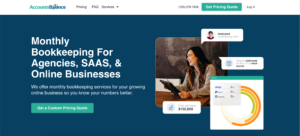
There isn’t a specific set of SaaS accounting standards to follow. SaaS businesses use the same generally accepted accounting principles (GAAP) or International Financial Reporting Standards (IFRS), depending on their location. However, we find some specific considerations when applying these standards to the SaaS business model. In this post, we’ll go over these along with other factors that pertain to recording and reporting financial activities.
The Basics of SaaS Accounting Standards
First off, SaaS companies typically follow ASC 606 (US GAAP) or IFRS 15 for revenue recognition. These standards require you to recognize revenue over the subscription period as the service is delivered. This means that you report it even if you have not yet received payment.
This is different from traditional product sales, but similar to sales on credit. Since you recognize revenue over time, you record unearned customer payments on the balance sheet as deferred revenue. This represents the customer’s liability for the service not yet delivered.
SaaS companies usually track key metrics like Customer Acquisition Cost (CAC), Customer Lifetime Value (CLTV), and Monthly Recurring Revenue (MRR). You need to know these metrics for proper financial analysis and growth planning within the industry.
Why These Standards are Crucial
SaaS businesses don’t get a separate accounting rulebook, but understanding how to apply GAAP or IFRS to your business model is vital.
Adhering to SaaS accounting standards guarantees better accuracy and transparency in financial reporting. This ensures that your financial statements are more reliable for investors, creditors, and other stakeholders to make informed decisions. Accurate financial reporting builds confidence in potential investors. Following the accounting standards also ensures that you comply with regulations and avoid fines and penalties.
When you follow standardized practices, you also have a consistent framework to depend on. This way, you can benchmark your performance against industry averages and identify areas for improvement.
Accurate financial data underpins informed decision-making. Standards help you allocate resources effectively, set realistic goals, and track progress towards those goals. They also allow you to create accurate financial forecasts that will help you plan for future growth, manage cash flow effectively, and make strategic business decisions.
Beyond attracting investment, adherence to accounting standards makes your company more attractive for potential mergers and acquisitions. If your company plans to go public, you must comply with accounting standards to get listed on a stock exchange. Moreover, you minimize errors when you follow standardized accounting practices, which protects your company from potential legal repercussions.
A Note on SaaS Accounting Tools for SaaS Businesses
SaaS accounting is cloud-based software, accessible from any device with an internet connection. These solutions store data securely on remote servers that the SaaS provider maintains.
Traditional accounting software is installed on individual computers or a local server where data is also stored. Local storage can greatly reduce the risk of cyber threats, but that depends on your internal IT practices.
Most SaaS solutions use excellent security measures like firewalls, data encryption, and access controls. They also backup your data regularly to ensure data recovery in case of technical issues. With local solutions, you are responsible for your own backups.
SaaS solutions are highly scalable. You can choose from tiered subscription plans and move to accommodate business growth. Providers rarely update pricing for existing customers. You also don’t have to worry about the upfront licensing costs or IT infrastructure expenses that are common with computer software.
SaaS solutions allow you to add or remove users quickly and easily. They also often integrate seamlessly with various business tools. Traditional accounting software offers limited scalability, and even when available, usually means paying more for additional licenses or hardware upgrades. Integration is also limited, mainly because of more popular SaaS solutions.
You and other users can access SaaS accounting tools from anywhere with an internet connection. This makes them ideal for remote teams that can’t use the same computer that you do. If you want data analysis, automated reports, and real-time access to financial data, you need a SaaS solution. All of this is manual work with traditional accounting software.
The best distinction between SaaS accounting tools and traditional software is the burden of responsibility. On top of the demand for better security and convenience, SaaS providers are responsible for compliance. They must ensure that their software adheres to all the relevant accounting standards. This makes it a far more reliable and cost-effective approach to financial management for most businesses.
Key SaaS Accounting Standards to Follow in 2024

Revenue Recognition (ASC 606 / IFRS 15)
ASC 606 and IFRS 15 are international accounting standards. They dictate how your business recognizes revenue for contracts with customers. These standards aim to improve consistency and transparency in your financial reporting. This is especially true for companies whose contracts involve multiple goods or services delivered over time. This is very common for SaaS companies.
The core principle of ASC 606 / IFRS 15 is that your business recognizes revenue as it transfers control. This means when you hand over the promised goods or services to the customer. In other words, it happens when the customer has the ability to use or benefit from the good or service. At this point, the company is typically no longer obligated to perform further actions, unless ongoing service is part of the deal.
For this to happen, your business needs to either identify individual contracts or combine multiple contracts into a single contract for accounting purposes. Then you need to identify the performance obligations in the contract. You can only recognize revenue when you fulfill the promise of the distinct goods or services.
Next, you must determine the transaction price, which is the total amount that the customer must pay in exchange. Then you allocate the total price to each performance obligation based on its relative standalone selling price.
Your business then records unearned customer payments for undelivered services on the balance sheet as deferred revenue. This represents the customer’s liability for the service not yet delivered.
ASC 606 / IFRS 15 provides a few benefits to SaaS companies. First, you get improved comparability in financial statements and a clearer picture of how revenue is generated. This leads to more transparent financial reporting and better decision-making on pricing, resource allocation, and performance measurement.
Capitalization of Development Costs (ASC 350-40 / IAS 38)
ASC 350-40 and IAS 38 are accounting standards that dictate how companies capitalize. In other words, companies can expense the costs associated with developing intangible assets, such as software. These standards help ensure that companies only capitalize costs that are likely to generate future economic benefits.
The standard dictates that the development project must be expected to create an intangible asset. Furthermore, the asset must be identified and separated from the business. The company also needs to demonstrate the technical feasibility of completing the intangible asset to function as designed. The company furthermore needs to demonstrate a plan for the intangible asset to be used or sold. This must generate probable future economic benefits. This could mean evidence of a market for the asset, the ability to produce it for sale, and the necessary rights to use or sell it.
The costs incurred through all this must be directly attributable to the development of the intangible asset. This includes costs for materials, labor, and overhead that is directly related to the development process. The business must measure capitalized costs at their historical cost. This includes all expenditures incurred to bring the asset to its current location and condition.
Costs that are typically expensed under this standard include research costs, which are associated with general discovery activities. Internal costs are those associated with routine activities like employee salaries or administrative expenses. The business expenses costs that are not directly related or attributable to the development of the specific intangible asset as incurred.
Capitalization offers benefits like improved asset valuation through a more accurate representation of the company’s intangible assets. It also allows companies to match the costs of developing an intangible asset with the revenue it generates in the future.

Customer Contract Costs (ASC 340-40)
ASC 340-40 is an accounting standard issued by the Financial Accounting Standards Board (FASB) in the US. It deals with accounting for the costs associated with obtaining or fulfilling a customer contract. It outlines the criteria for recognizing these costs as an asset or an expense.
This standard focuses on incremental costs. This means the additional costs a company incurs specifically to obtain a customer contract that it would not have incurred otherwise. These costs can include sales commissions paid to employees, legal fees associated with negotiating the contract, and travel expenses directly related to securing the contract.
ASC 340-40 dictates whether incremental costs should be capitalized as an asset or expensed as incurred. Costs can be capitalized if you expect to recover them through future revenue generated from the contract. If capitalized, the costs are expensed systematically over the period the company benefits from the customer contract. You should align this amortization period with the pattern of revenue recognition from the contract.
Capitalizing and amortizing costs allows companies to match the expense of acquiring a customer with the related revenue generated over the contract life. This provides a more accurate representation of a company’s profitability. By separately identifying and accounting for customer contract costs, you can generate more informative financial statements for analysis purposes. Note that accurately estimating the amortization period for capitalized costs can be challenging, especially for complex contracts.
Financial Instruments (ASC 820 / IFRS 9)
ASC 820 and IFRS 9 are the accounting standards that govern how companies recognize, measure, and report financial instruments. These standards apply to a broad range of financial instruments. They include cash and cash equivalents, loans and receivables, debt securities, equity instruments, ans derivatives.
A key aspect of the standards is classifying financial instruments based on their characteristics and how an entity manages them. You would measure financial instruments held for trading or with certain characteristics at fair value. You then recognize gains or losses in the current period’s profit or loss. Usually, you would measure debt instruments held to collect contractual cash flows at amortized cost.
The standards require companies to assess their financial instruments for impairment. This means a loss in the expected future cash flows from the instrument. If you can identify an impairment, you recognize a loss in the income statement.
Companies can use hedge accounting to offset the risks associated with certain financial instruments. This can help to reduce volatility in reported earnings.
These standards enhance transparency by requiring more detailed disclosures about financial instruments. This allows for a better understanding of a company’s financial position and risk profile. The focus on fair value and impairment encourages companies to actively manage their financial instrument risks. The standards also facilitate better comparability of financial statements across different companies through a consistent accounting framework.
Frequently Asked Questions
How do international accounting standards affect SaaS companies operating globally?
International accounting standards like IFRS promote standardization. This allows investors and stakeholders to compare financial performance across different countries and currencies more easily. This can be beneficial for SaaS companies seeking international investment or planning to expand into new markets.
These standards also have specific guidelines for revenue recognition, impacting how SaaS companies report their revenue and profitability. They also treat deferred revenue from annual or multi-year subscriptions differently.
SaaS companies operating in multiple jurisdictions might need to comply with different accounting standards, complicating reporting and bookkeeping. Meeting compliance requirements might incur additional costs, too.
Are there any common misconceptions about SaaS accounting standards that businesses should be aware of?
Businesses should be aware of at least these two common misconceptions to avoid encountering roadblocks or making misinformed decisions. First, even free trials can have accounting consequences. Consult with your accountant to determine the appropriate treatment for free trials based on your specific offering. Second, while basic bookkeeping software might work for simple businesses, SaaS accounting often requires specialized features. These might include subscription management tools, multi-currency capabilities, and integrations with revenue recognition automation tools.
What Is AccountsBalance?

AccountsBalance is a monthly bookkeeping service specialized for agencies & SAAS companies.
We take monthly bookkeeping off your plate and deliver you your financial statements by the 15th or 20th of each month.
You’ll have your Profit and Loss Statement, Balance Sheet, and Cash Flow Statement ready for analysis each month so you and your business partners can make better business decisions.
Interested in learning more? Schedule a call with our CEO, Nathan Hirsch.
And here’s some free resources:
In Summary
SaaS companies follow the same general accounting standards as other businesses. Specific guidelines do apply to recognizing revenue over the subscription period, though. Understanding how GAAP or IFRS applies to the unique aspects SaaS businesses is essential for accurate financial reporting.
Remember that ASC 606 applies to US companies and IFRS 15 is the international standard. The specific details of these standards can be quite complex. If your business offers SaaS services, we recommend consulting with a qualified accountant to ensure proper implementation.








